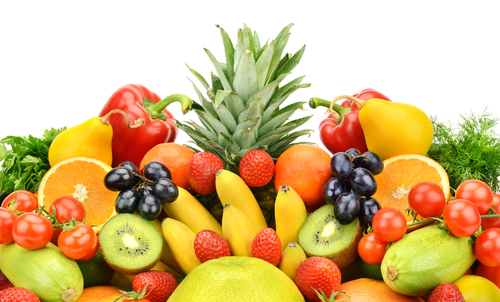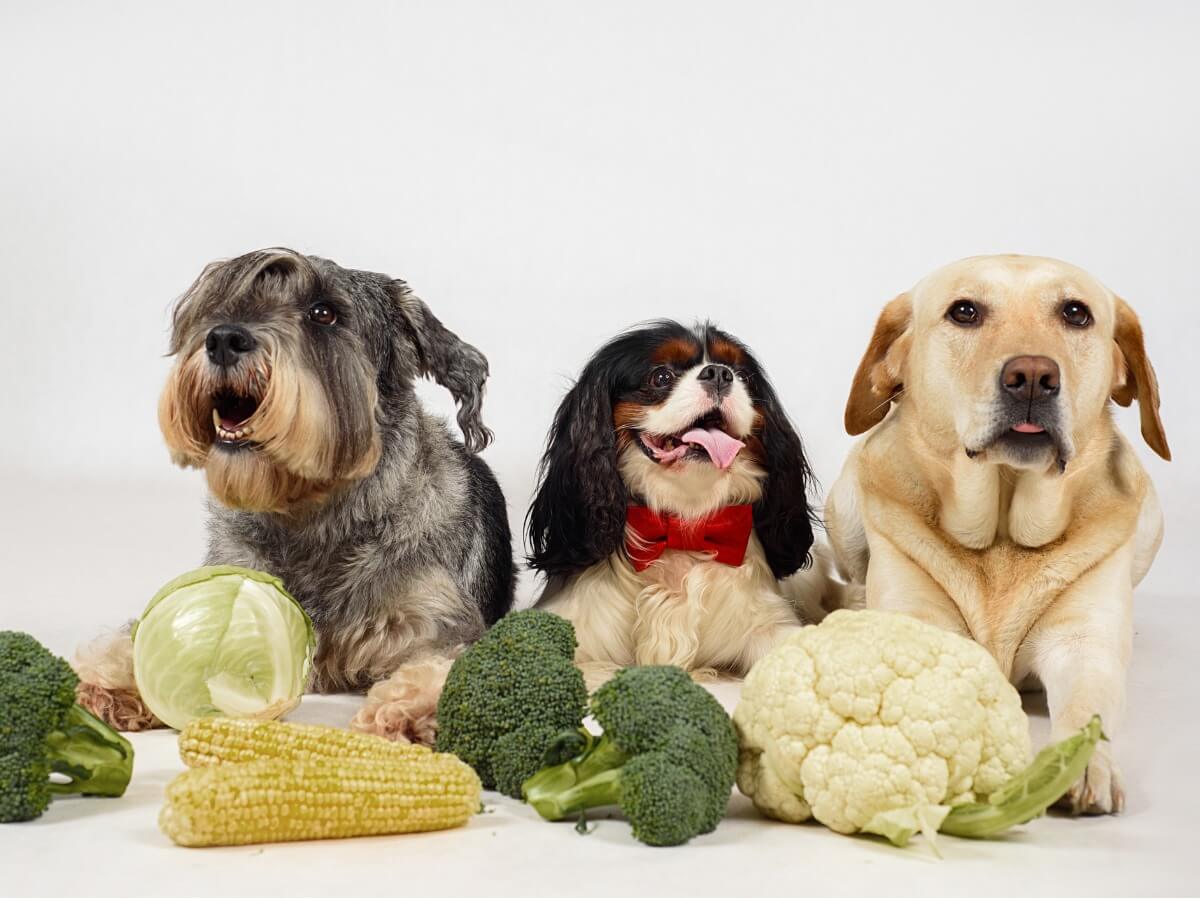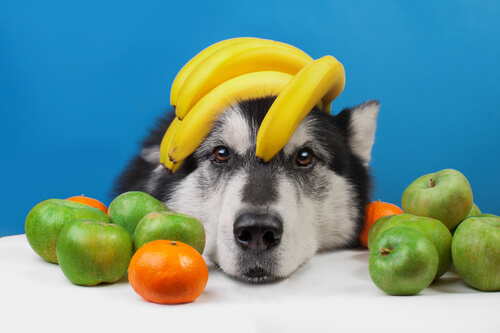17 Harmful and Toxic Fruits and Vegetables for Dogs

Many owners love to share a meal with their four-legged pet. Dogs often approach the table, put on a sad face and make it difficult to resist them. In spite of this, we must keep in mind that there are certain foods that aren’t only inadvisable for canines, but also quite harmful. We’ve compiled a comprehensive list of toxic fruits and vegetables for dogs for you.
Being aware of the food we give our dog can avoid several complications such as vomiting, diarrhea, and, in the most serious cases, anemia, hypertension, irregular heartbeat, convulsions, and even death. The seriousness of the symptoms will depend on the amount of unsuitable food eaten.
In order for you to learn about the food a dog should not eat, here are 17 toxic fruits and vegetables for dogs that could be harmful for them.
Are there toxic fruits and vegetables for dogs?
Dogs are facultative carnivores. This means that a large part of their diet must be made up of animal proteins (more than 20%), but they can also ingest carbohydrates, vitamins and other compounds of vegetable origin sporadically. Without going any further, most feedstuffs contain cereals and legumes as a base.
While your pet is in the growth stage, it’s best to stick to the diet recommended by the veterinarian and avoid feeding it food from the table. This isn’t because natural foods are bad, but because it’s very difficult to control caloric and nutritional intake with ingredients from home.
During the dog’s adult stage, fruits and vegetables can be incorporated in small amounts and in the form of treats or snacks. As from 7 years of age they need a greater amount of fiber in their diet.
However, you need to be careful, because there are some toxic fruits and vegetables for dogs that will harm their health. It’s best to consult with your veterinarian about incorporating these foods into your dog’s daily routine.
Dogs have a less sophisticated digestive system than humans. For this reason, they can’t process foods, such as very fatty and spicy foods, in the same way. Nor can they take advantage of vegetable proteins in the same way.
Dogs don’t have digestive enzymes in their saliva, so they tend to take longer to break down some carbohydrates in the stomach. However, they have a more acidic pH to break down meat proteins and kill certain dangerous bacteria.
In addition, it’s important to keep in mind that, besides the toxic fruits and vegetables for dogs, there are other ingredients in the kitchen that can cause allergies or individual intolerances. It’s best to be very attentive to your dog’s reaction to the ingestion of any compound and to consult a veterinarian if you notice any oddities.

Here’s a list of 17 harmful or toxic fruits and vegetables for dogs
Although the vast majority of fruits and vegetables can be offered to dogs with moderation, certain ingredients are completely (or partially) forbidden. We’ll show them in the following list.
1. Grapes or raisins
Grapes and raisins have no visible effect on dogs in all cases, but they’re difficult for dogs to digest and can cause irreversible kidney damage. A small portion can trigger problems, so consumption of any amount should be considered a potential danger to the dog.
The exact compound in these fruits that causes discomfort in dogs isn’t known, but the following signs are common after ingestion:
- Loss of appetite
- Generalized lethargy
- Vomiting and diarrhea
- Dehydration
- Overproduction of urine
- Abdominal swelling
These clinical signs are applicable to almost all of the items in the list below.
2. Onions and garlic
Onions, garlic, and similar vegetables (such as leeks or scallions) cannot be included in the canine diet. These foods are dangerous for dogs in high or repeated doses, as they contain thiosulfate, which can destroy canine blood cells and cause anemia.
Ingestion of these vegetables can also cause lethargy, tachycardia, hyperventilation, pale gums and, in severe cases, respiratory collapse.
3. Cherries
Cherries are not actually dangerous for dogs, as the pulp is juicy and its consumption quenches thirst in the hottest moments of the summer. What is harmful is the stone or seed, because it contains cyanide and, if swallowed, can cause respiratory failure or death in the dog.
However, you can offer chopped cherries to your dog if you remove the stones. This fruit is excellent in juices, ice creams, and yogurts for dogs, as it has a very attractive color and a very appetizing flavor.
Apricot pits have the same problem, so you should also be careful when giving these fruits to your pet.
4. Wild mushrooms
As with humans, some wild mushrooms or fungi are toxic to dogs, so you need to keep an eye on your pet when walking in the countryside so that it doesn’t eat any of these natural elements.
Not all wild mushrooms are harmful, but it is always better to be safe than sorry. Be aware that some fungal species can be fatal for dogs.
Unidentified mushrooms can cause multi-organ failure within hours. If you suspect that your dog has consumed an unknown mushroom, don’t hesitate to take them to the veterinarian and, if possible, with a specimen of the mushroom you think they have ingested (or of all the mushrooms around).
It’s important to mention that the known and commonly sold species of mushrooms don’t represent any danger to dogs. However, as the wild mushrooms that grow in fields or forests aren’t known, it’s best to take care of your pet while walking in these places.
Although only about 100 of the 50,000 mushroom variants that exist are toxic, it’s better to be safe than sorry and prevent your dog from ingesting any of them.
5. Currants
Currants are just as harmful to dogs as grapes or raisins. It isn’t known exactly what compound produces this reaction, but they are quite toxic and can cause kidney failure if given on a regular basis.
6. Green potatoes
Potatoes that haven’t fully matured, or raw potatoes with green sprouts, contain solanine, a harmful compound that can cause nausea, vomiting, convulsions, and heart problems in your dog. This alkaloid disappears when the tubers are cooked, so it’s fine to give your dog cooked potatoes.
Solanine is also found not only in potato plants, but in any plant that has leaves, so don’t let your dog run around in an orchard or allow them near a planting.
Ripe, cooked potatoes aren’t a bad addition to a dog’s diet, but they should always be prepared.
7. Rhubarb
Rhubarb is a tuber that’s used mainly in baking. In dogs it causes imbalances in calcium levels and can lead to kidney failure.
8. Apples
The apple itself isn’t bad for dogs and the pulp is very good for them. Unfortunately, the seeds contain cyanide, which can lead to respiratory failure or even death if ingested in large quantities. If you want to offer this fruit to your dog, make sure it’s in chunks and without the skin or seeds.
This is one of the toxic fruits and vegetables for your dog that you should be more aware of, as all owners have apples at home.
9. Green tomatoes
Green tomatoes and the plant cause acute stomach pain in dogs due to the presence of solanine, the toxic compound already mentioned in the section on potatoes. Therefore, dogs should be prevented from prowling through vegetable gardens and chewing on tomato stems or leaves.
Fortunately, ripe tomatoes (red in color) are not toxic to dogs and can be eaten in moderation. They’re rich in water, so they’ll help hydrate the animal in the summer months if mixed with meat and other compounds to their liking.
10. Avocados
Avocados are indigestible to dogs because they contain persin, a fungicidal substance (which kills fungi and molds) that is toxic to several species of animals, such as dogs, cats, horses, and some birds. Persin is present in the leaves, fruit, and seeds, so dogs shouldn’t be left near an avocado tree.
11. Asparagus
Asparagus shouldn’t technically be part of out list of toxic fruits and vegetables for dogs, but it isn’t recommended that you include it in your dog’s diet. Although they don’t contain harmful compounds, in their raw form they’re very difficult to bite and digest. If you cook them until they turn to mush, they lose their main properties and your dog won’t benefit at all from eating them.
12. Lemons
In general, dogs don’t like the taste or smell of lemon. In addition, it isn’t advisable to offer it, as it can cause gastrointestinal problems and irritation due to the citric acid and essential oils present. It is also necessary to be careful with the plant itself and to prevent the dog from consuming any of its parts. The same applies to other citrus species.
13. Almonds
Dogs don’t digest the proteins present in almonds and other nuts well, which can cause certain intestinal disturbances. In addition, they contain large amounts of fat that promote obesity in dogs if they’re fed too often.
14. Nutmeg
Although it isn’t a common ingredient in most kitchens, it should be noted that nutmeg is very toxic for dogs. This ingredient causes tremors, seizures, and even death in dogs in very low doses. Be very careful if you have it at home.
15. Persimmon
Persimmon has only been on the market for a short time, and is also quite harmful to dogs. Its seeds contain substances that cause them to have diarrhea and elevated body temperature.
16. Macadamia nut
The Macadamia nut is a fruit of an Australian tree that contains toxic compounds in its seeds. Clinical manifestations usually include weakness, vomiting, tremors, abdominal pain, and pale mucous membranes, among other signs.
Some dogs show signs of intoxication with small ingestions of as little as 0.7 grams per kilogram of body weight. However, the response can be variable and the exact minimum danger dose isn’t yet established.
17. Tamarind
Tamarind is another fruit that’s toxic to your dog, as it can cause acute kidney damage. The component that causes the discomfort is unknown. However, recent research published in the Journal Veterinary Emergency and Critical Care suggests tartaric acid as a possible toxic component.

Although some fruits and vegetables are harmful to dogs, many others have a wealth of benefits if provided in the right amounts. Check with your veterinarian when in doubt and always offer your dog the best food choices.
All cited sources were thoroughly reviewed by our team to ensure their quality, reliability, currency, and validity. The bibliography of this article was considered reliable and of academic or scientific accuracy.
- Buoro I, Nyamwange B., Chai D., & Munyua, S. (1994). Putative avocado toxicity in two dogs. Onderstepoort Journal of Veterinary Research, 6, 107-109. Recuperado de: https://repository.up.ac.za/handle/2263/33074
- Campbell, A. (2007). Grapes, raisins and sultanas, and other foods toxic to dogs. Companion Animal, 12(1), 77–79.
- Cortinovis, C., & Caloni, F. (2016). Household food items toxic to dogs and cats. Frontiers in Veterinary Science, 3, 36.
- Craig, J. (2019). Food intolerance in dogs and cats. Journal of Small Animal Practice, 60(2), 77-85.
- Donadelli, R. A., Jones, C. K., & Beyer, R. S. (2019). The amino acid composition and protein quality of various egg, poultry meal by-products, and vegetable proteins used in the production of dog and cat diets. Poultry science, 98(3), 1371-1378.
- Eubig P., Brady S., Gwaltney S., Khan A., Mazzaferro M., & Morrow M. (2005). Acute renal failure in dogs after the ingestion of grapes or raisins: a retrospective evaluation of 43 dogs (1992-2002). Journal of veterinary internal medicine, 19(5), 663–674. Recuperado de: https://pubmed.ncbi.nlm.nih.gov/16231710/
- Kovalkovičová, N., Sutiaková, I., Pistl, J., & Sutiak, V. (2009). Some food toxic for pets. Interdisciplinary toxicology, 2(3), 169–176.
- McKenzie, R., Purvis-Smith, G., Allan, S., Czerwonka-Ledez, B., Hick, L., Dunn, M., King, I., Deeley, D., Kelly, W., & Day, C. (2000). Macadamia nut poisoning of dogs. Australian Veterinary Practitioner, 30, 6–10.
- Martin, J. (1985). Beautiful But Dangerous: Plant Poisoning in Pets. Bellwether Magazine, 1(14), 4.
- Pereira A. M., Pinto, E., Matos, E., Castanheira, F., Almeida, A. A., Baptista, C. S., … & Cabrita, A. R. (2018). Mineral composition of dry dog foods: Impact on nutrition and potential toxicity. Journal of agricultural and food chemistry, 66(29), 7822-7830.
- Wegenast C., Meadows I., Anderson R., Southand, T., González, C., & Wismer, T. (2022). Acute kidney injury in dogs following ingestion of cream of tartar and tamarinds and the connection to tartaric acid as the proposed toxic principle in grapes and raisins. Journal Veterinary Emergency and Critical Care, 32(6), 812-816. Recuperado de: https://onlinelibrary.wiley.com/doi/10.1111/vec.13234